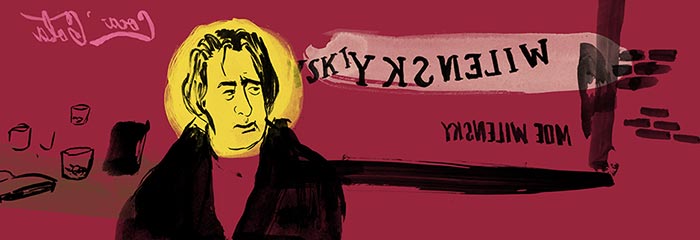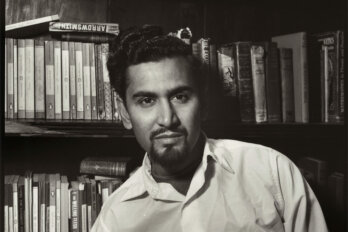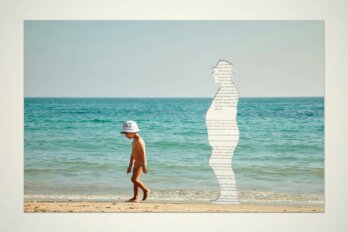Mordecai: The Life and Times by Charles Foran
Knopf Canada (2010), 800 pp.
In 1973, forty-two-year-old Mordecai Richler spoke at a Jewish student conference in Niagara Falls, Ontario. After meeting the students the night before and hearing their concerns about a university dance that conflicted with the Sabbath, he abandoned his prepared notes. He had written, he told them, a speech about literature and nationalism. “I left that in my hotel room. Because it would be a waste to deliver it here.” The assault lasted half an hour. He called them ignorant bigots. He said he had considered painting swastikas on the hotel to help them certify their “ghetto paranoia.” He said while they worried about Friday night dances, babies burned in Vietnam. He said they needed not only a Jewish education, but an education.
So begins Charles Foran’s Mordecai, the fourth version so far of the life of a Jewish punk from Montreal, son of a junk dealer and a rabbi’s daughter, the hard-working, hard-living, perpetually rumpled, abrasively honest Mordecai Richler. It was a full, rich life, and it’s a full, rich book—over 700 pages spanning just over seventy years. It’s thick with names famous and forgotten, from the complicated families of St. Urbain Street, to chance meetings and long friendships with writers, actors, producers, publishers, and power brokers in Paris, London, New York, Montreal, and Toronto. (And, of course, the enemies—not all of whom were Jewish. Or French.)
The promotional material for Mordecai promises a full revelation, “warts and all.” Seems to me Richler wore the warts that mattered proudly enough himself, but for the curious they’re certainly here: Richler insulting his paying hosts, whether students or university administrators. Hitting on his second wife on the evening of his wedding to his first. Slipping out of his own book launch to court, successfully, a rival publisher. Abandoning the agent who stood by him through three immature novels soon after the success of his fourth, the breakthrough Duddy Kravitz. Cutting off his mother, wacko or not. And, naturally, what Richler did best, firing broadsides in print or in person at his targets of the times, whether Jewish bootleggers, Canadian nationalists, French separatists, or the gay waiter who asked him to put out his cigar: “I don’t tell you what to put in your mouth,” he said. Mordecai Richler earned his hate mail.
Foran balances these scenes with others of stubborn loyalty to friends and family, and assures us of “equal numbers of stories of the courteous, kindly Richler.” He doesn’t tell these stories so often as the other kind, but there’s likely not a lineup of people looking to read about the “courteous, kindly Richler.” In the end, Richler was loved by his wife, his children, and his closest friends. For a man, that’s enough. At his funeral, son Jacob called him “a better father and husband than a novelist,” while daughter Martha squared her shoulders into grief and said, “Fuck you to all cancer.” With kids like that, who cares what anyone else thinks?
For a writer, none of it matters—the good, the bad, or the ugly. As Richler told an interviewer in the early ’70s, “Whether a writer is a marvellously charming, agreeable, generous man or whether he beats his wife and tortures his children is beside the point. The books are what matter one way or the other, and the two should not be confused.” His last publication, his column in the National Post for May 5, 2001, was called “Don’t Look to Writers for Morality Lessons.” We judge a man by his life, a writer by his books. Charles Foran has done a thorough and thoughtful job of the first. Time will do the second.
—Nick Mount

Mr. Shakespeare’s Bastard by Richard B. Wright
HarperCollins Canada (2010), 352 pp.
There is a perception that the fiction of Richard B. Wright has a certain safety to it, a gentleness. You can see it in the review quotes on advance copies of his latest novel, which use words like “profound, graceful,” “subtle,” and “gently persuasive” to describe his previous fiction. All of these are true, but they mask an underlying truth: beneath the book club–friendly veneer and the elegant, seemingly effortless prose, Wright is one of our most brutal, clear-eyed, unflinching writers.
Take Mr. Shakespeare’s Bastard, a novel which tells two stories. The primary narrative follows Aerlene Ward, an aging housekeeper at Easton House in Oxfordshire in 1658, as she goes about her days, settling petty fights among the staff, nurturing the family, and dictating a story to the youngest Easton daughter, Charlotte. That story is an account of Aerlene’s mother, Elizabeth. The pivotal period in Elizabeth’s short, unhappy life was the time she spent in London, working as a shopgirl. She had left her village home in disgrace, and in London she fell in love with a young actor, William Shakespeare—Aerlene’s father. Aerlene grew up with her mother’s stories of the actor, and read A Midsummer Night’s Dream to Elizabeth on her deathbed.
The bard haunts her life until the fateful afternoon when she finally meets him. Then the paired storylines unfold with a seamless beauty, eliding and complementing each other, illuminating two vastly different worlds and lives. Wright brings an easy command of social history to bear, on both life within Easton House, with its petty fiefdoms and troubled legacy, and on the squalid, crowded, wonderful streets of London. Similarly, his characterizations are compelling and rich. Even minor characters, including Elizabeth’s fundamentalist aunt, and a cross-dressing prostitute who befriends Elizabeth early in her London sojourn, are captivating and well drawn.
Readers expecting something akin to Shakespeare in Love, however, would be well advised to look elsewhere: Mr. Shakespeare’s Bastard is not a frothy, joyous, bittersweet novel. Rather, like the majority of Wright’s fiction, it is rooted in pain and loss, and the sort of despair that lasts a lifetime. His love for these characters is clear, but it is a brutal, unapologetic love: he loves them for their strength, for their perseverance in the face of pain and sorrow, their resolve. For Wright, survival is a triumph, and happiness is a gift rarely received.
—Robert J. Wiersema

The Death of Donna Whalen by Michael Winter
Hamish Hamilton (2010), 272 pp.
In 1959, Truman Capote came across a 300-word New York Times article detailing the murders of Herbert Clutter and his family in Holcomb, Kansas. Capote’s fascination with the story led him to the notion that he could tell the tale of the murders, and the subsequent execution of the convicted killers, using a novelist’s techniques and tools. The result was the groundbreaking true crime work In Cold Blood (1966), a book to which Michael Winter alludes in the foreword to his new work of “documentary fiction,” The Death of Donna Whalen.
Based on a murder that took place in St. John’s, Winter’s book tells the story of Whalen’s brutal killing—she was stabbed in her home, thirty-one times—and the police investigation that followed. He uses a combination of court transcripts, police wiretaps, newspaper reports, and interviews with actual persons involved in the case to reconstruct, in collage-like fashion, the events surrounding Whalen’s death.
In this sense, Winter’s book less resembles Capote’s seminal work than another product of “new journalism”: Norman Mailer’s Pulitzer Prize winner, The Executioner’s Song (1979). Winter does Mailer one better, concealing the characters’ real names and cutting up the story’s chronology. The short, polyvocal sections of the novel also recall William Faulkner’s As I Lay Dying. But if The Death of Donna Whalen wears its literary influences on its sleeve, it is also sui generis in the annals of CanLit: a non-fiction novel with a sensibility and a moral imperative more modernist than postmodernist.
Whalen was a single mother and small-time shoplifter; her boyfriend, Sheldon Troke, had a criminal record and a history of violence. Because he was known to police, he became the obvious suspect in her murder, and as the story unfolds the reader is able to piece together how the instruments of law enforcement built a case against him that was largely circumstantial and based on conflicting witness accounts. Further, it becomes apparent that the police coerced certain testimony from various witnesses, including, most reprehensibly, Donna’s young daughter, Sharon, who discovered her mother’s body. All of this congeals into a dark morality tale about violence, class, and state corruption.
Because the book cleaves so closely to the documents in the case, and preserves the precise rhythms and cadences of Newfoundland speech, it is not an easy read. However, as found by Gary Bemister, one of the investigating cops in the story, who “found the more you listened to the tape the more your ear got attuned to the voices,” the dialects become easier to follow as the book progresses. Moreover, as with any modernist work, the surface tension belies the craft underpinning it: Winter’s prose is austere and declarative, and he uses repetition as a kind of incantatory device, rendering the writing more rhythmic and euphonic than it might otherwise be.
This is a dense, difficult text that requires concentration and close reading. But it is a brave work that showcases a stylist playing to his strengths, and it will undoubtedly reward the patient reader.
—Steven W. Beattie

The Beauty of Humanity Movement by Camilla Gibb
Doubleday Canada (2010), 304 pp.
In Camilla Gibb’s new novel, the best pho in Hanoi is not sold at an elegant restaurant or a busy street stall. Only a small but dedicated group of regular customers can find it, as they embark on a daily odyssey to find Old Man Hu’ng’s travelling pho cart, which could be parked anywhere from a back alley to an empty swimming pool. There, they enjoy Hu’ng’s succulent broth, the “subtle dance of seasonings” of a recipe that has persevered, along with its cook, through decades of war and poverty.
The elderly Hu’ng is at the core of The Beauty of Humanity Movement, a panoramic portrait of Vietnam’s past and present. While Hanoi is now a modern tourist destination, Hu’ng remains a vestige of Vietnam’s troubled history. Despite the city’s abundant amenities, he stubbornly clings to his life in a shantytown hut, washing his pots in a pond and sleeping on a straw mattress. The narrative ambles through Hu’ng’s history, illuminating an existence that has been both tormented by loss, and invigorated by his involvement in the ’50s with a cadre of spirited intellectuals who struggled to liberate art from the confines of an oppressive regime.
Woven into Hu’ng’s story are those of Maggie, a Vietnamese American hoping to gain insight into the life of her long-dead father; and Tu’, a Nike-clad tour guide who finds himself increasingly frustrated by the artificial, pastoral image of Vietnam he is forced to perpetuate. Compared to the obstinate, wounded Hu’ng, however, these characters seem flat, their middle-class existential dilemmas trivial.
Gibb’s prose can be cloying, but it conveys the scope of her subject matter. She skilfully illustrates the war’s impact on contemporary Vietnam by personifying its landscape as a human victim—“pockmarked and battle-scarred” roads, the “hollow carcass” of a building, the “bloodless kidney” of a swimming pool.
Her writing is at its strongest when describing the food her characters eat: the “buttery collapse” of a pork dish, the steam from the pho “rising like incense smouldering in a temple.” Aside from tantalizing the senses, these passages underscore how for Gibb’s characters food means more than just sustenance; it represents family, culture, and, most important, survival. Few scenes in the novel are more memorable than Hu’ng’s recollections of having to use pondweed to make vermicelli noodles during the war, or of killing the last duck in the village for his broth.
“The history of Vietnam lies in this bowl,” Gibb writes. In her hands, pho becomes a poignant testament to the tenacity of Vietnam itself.
—Emily Landau

Light Lifting by Alexander MacLeod
Biblioasis (2010), 224 pp.
That Light Lifting, Alexander MacLeod’s debut story collection, will be anything but light is apparent from its stark black and white cover shot: a train tunnel at night, with only a distant opening visible at the end. “It’s the light lifting,” the title story’s narrator, a bricklayer, remarks farther along, “that does the real damage.” Indeed, this thin volume, just seven stories strong, devotes itself to the life-altering events that overtake or burden us as we work, day to day, toward the end light.
The train tracks beckon the reader first into “Miracle Mile,” a study of a long-distance runner nicknamed Burner. Set around a Canadian championship race, the story quickly jumps back to a near-death experience in which Burner barely escaped a train while racing down the Detroit–Windsor tunnel at night. “He was like that one stupid gazelle on the nature show, the one who somehow gets away even though the cheetahs or lions or hyenas should already be feasting,” recalls the narrator, a close friend and co-miler who came out of the tunnel minutes earlier. The incident imprints Burner as an adrenalin junkie—someone who encourages conflict, who creates personal and athletic deficits to draw out what is greatest from within himself. Weaving in and out of flashback, MacLeod shows the ramifications of this tendency before, during, and after the race, to great effect.
The narrators of Light Lifting are often working-class men and boys, and the Windsor-raised MacLeod, a holder of three university degrees and the son of noted author and professor Alistair MacLeod, struggles at times to inhabit their thoughts. His primary modes for conveying the internal lives of people less erudite than he—Salinger-style lassitude and Papa-brand staccato—don’t always ring true. When the prose expands too loosely, narrators are left waxing philosophical at awkward times, and in awkward ways: “We are made most specifically by the things we cannot bear to do,” we learn, inopportunely, as a girl who nearly drowned as a child ponders whether to swim out to rescue her lover. When the prose constricts too tightly, it feels self-conscious, almost condescending, as though the narrator isn’t eloquent enough to swim even the calmest streams of consciousness without frequent stops. One flashback, for example, begins, “Origins. A pretty girl in a bar. Notice her Clash t-shirt. Combat Rock. Probably second hand.”
The story from which this quotation is drawn, “Wonder About Parents,” unfolds unvaryingly in this shorthand. It also labours under a certain telegraphed showiness about the author’s research (the male lead just happens to be reading a book on the history of lice). Yet it may be a sign of MacLeod’s promise that it ended up as my favourite of the collection, thanks to his strong storytelling and profound empathy for his characters. The story draws to a close with the wondered-about parents keeping a nighttime vigil over their sick baby. For a brief few paragraphs, the punctuation ceases to intrude, hearkening instead to the peace of the moment. The endnote is exceedingly graceful and sweeping, bearing out much of what has gone before. It wouldn’t be out of place in Cheever. Were it not in fragments. That is.
—Jeremy Keehn

Far to Go by Alison Pick
House of Anansi (2010), 314 pp.
Alison Pick brings her award-winning poetic sensibilities to a difficult historical subject in Far to Go. A complex story of a family’s struggle set against the backdrop of the Nazi takeover of Czechoslovakia’s Sudetenland, the novel focuses on the Bauer family, secular Jews caught in the rise of anti-Semitism. Patriarch Pavel Bauer is a respected, rich business owner who, with his wife, Annaliese, refused to face the reality of occupation and can no longer obtain the necessary permission to cross the border. They attempt to find safety for their six-year-old son, Pepik, via the Kindertransport, a passage for children from Nazi-occupied countries to be rescued by families in Britain. Also central to the storytelling is Marta, the housekeeper, a young woman deeply involved in the family, and the primary force behind the book’s emotional resonance.
There are lines here perfect in their despair and desolation. The hopelessness and fear is conveyed in typical Pick style—with both a light hand and a punch to the gut. Pick successfully hinges together the complex narrative twists with historical records, letters, and fragments of history. Passages about Pepik, a child fleeing persecution, losing a family, and eventually starting a new life, are heart rending. There are times, however, when the narrative loses its charge—slowed down by lengthy, unnecessary description, and leaning on a particular brand of formulaic drama. Pick’s beautiful language, however, is strong enough to support these weaker points.
Pick artfully reveals the Bauer family’s fate, and traces the ties that bind (and confine) their complex dynamic. Beyond the simple explanations of xenophobia and hatred, the novel reveals the realities of betrayal, secrecy, resentment, and bitterness in its perpetually broader historical tragedy.
—Stacey May Fowles

The Madman and the Butcher by Tim Cook
Allen Lane Canada (2010), 400 pp.
Canada has yet to come to terms with the legacy of the First World War. While our soldiers won lasting international renown at Vimy Ridge and Passchendaele, such victories exacted a mind-numbing price: more than 60,000 dead by war’s end, and many more broken in mind and body. In The Madman and the Butcher, award-winning historian Tim Cook takes just measure of both the glory and the cost of Canada’s most important war by telling the intertwined stories of two leading figures, Sam Hughes and Arthur Currie.
Both were Ontario farm boys who rose through the ranks of the pre-war militia and found themselves elevated to the international stage. As minister of the militia, Hughes was a bombastic and successful recruiter whose cheerleading built up the national morale. But he was also an inept, unstable manager who filled the ranks with unqualified patronage appointments, and equipped his troops with faulty gear, notably the Ross rifle. The diffident, thoughtful Currie was a methodical, level-headed administrator who became one of the war’s greatest generals, not through displays of strategic brilliance, but rather by keeping his cool and learning from earlier mistakes.
By 1916, even the patient Prime Minister Borden concluded that Hughes was “unbalanced.” Ousted from power, the bitter Hughes went on a rampage against those he regarded as his betrayers. In an infamous 1919 tirade, he accused Currie of building up his own military fame by “needlessly sacrificing the lives of Canadian soldiers.” Hughes’s rant confirmed his reputation as a “madman” even as it tarred Currie with the label of “butcher.” By carefully reconstructing their lives and war experiences, Cook tries to rehabilitate both men, arguing that “the madman was no madman, the butcher no butcher.”
His attempt to paint both men in a favourable light is only partially convincing. Currie emerges as a genuinely heroic and tragic commander, a man who stifled his natural compassion to do a dirty job. But, working against his own argument, Cook provides a great deal of evidence to support earlier historians who described the minister of the militia as a madman. He refers to Hughes’s “unstable emotions,” “unhinged quality,” “manic behavior,” and “almost pathological [refusal] to delegate authority,” and suggests he was “either a liar or delusional or both,” “out of touch with reality at the front,” “irrational and unpredictable,” and prone to “ego-driven interferences, racist rhetoric, and manic actions.”
Cook complains that other historians have caricatured Hughes as “an unstable megalomaniac.” But based on Cook’s own evidence, Hughes was, if not a full-fledged lunatic, at the very least someone so unhinged he should never have held a position higher than that of potato peeler in a military canteen.
Despite its unpersuasive defence of Hughes, this book is a triumph of the historian’s craft, rich fare for both scholars and general readers. Confidently written and based on an impressive mastery of archival and secondary sources, it confirms Cook’s stature as our leading military historian.
—Jeet Heer
This appeared in the November 2010 issue.






